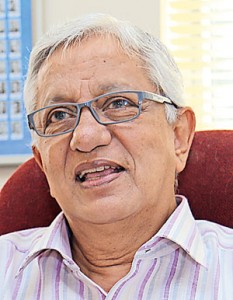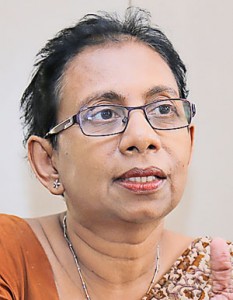‘Who are we?’

Dr. Ruwandi Ranasinghe: Fascinated by the ‘Eve Gene’. Pix by Anuradha Bandara
A joke oft chuckled over about lineage is that no one really knows who one’s father is – the only fact without dispute is who one’s mother is.
Jokes apart, this is the very pathway that a pioneering team of researchers from the Institute of Biochemistry, Molecular Biology and Biotechnology (IBMBB) of the University of Colombo has followed to clear fact from fiction, from the larger picture that is Sri Lanka, based irrefutably on science.
Will Sri Lanka have to re-write its history in the light of these very revealing or ‘set in genes’ findings, is the question on the minds of many.
Not just genes and their patterns has Dr. Ruwandi Ranasinghe peered at but that all-important ‘Eve Gene’ to shed light on the crucial questions buried in the dim mists of time.
Who are Sri Lankans? From where have we come? Are the major ethnic groups and also the Veddahs closely-linked or disparately different?
The indisputable findings based on the ‘Eve Gene’ or Mitochondrial DNA (mtDNA) should lead to stronger bonds among the major ethnic groups, making the call ‘We are Sri Lankans’ louder and clearer.
Traditional thinking on how the different ethnic groups arrived in this strategically-placed island is significantly contradictory to this ‘Eve Gene’ study which covered the Sinhalese, the Sri Lankan Tamils, the Indian Tamils, the Muslims, the Malays and the Veddahs. And the study findings are:
Contemporary Sri Lankans share very close maternal ancestors. Ethnicity is created by linguistic, religious and cultural differences, rather than genetic differences.
The differences between the major ethnic groups are minimal except in the case of the Veddahs who stand out as a separate cluster.
There is a considerable genetic admixture in contemporary ethnic groups in Sri Lanka — the Sinhalese are closely related to the Sri Lankan Tamils.
(According to traditional thinking an admixture of North Indians with the original inhabitants of Sri Lanka is reported to have established the Sinhalese ethnic group around 2,600 years ago. The Veddahs are thought to be remnants of the original inhabitants. The origin of Sri Lankan Tamils is attributed to successive invasions by South Indians beginning a few centuries later.)
The Muslims and the Malays are also closely related to each other.

Prof. Eric Karunanayake
(According to traditional thinking Muslims from the Arabian Peninsula arrived in the country between the 7th and 8th centuries, mostly as traders, while the Malays from Southeast Asia arrived during the Dutch occupation of Sri Lanka in the 17th and 18th centuries.)
The Indian Tamils are different to the Sri Lankan Tamils. (The Indian Tamils were brought to Sri Lanka mainly from Tamilnadu by the British in the 19th century.)
The Veddahs are the most distinct group but are a little close to the Sri Lankan Tamils
Our maternal ancestors have come from the ‘Out of Africa’ mtDNA lineage
The South Asian (Indian) mtDNA haplogroups are the commonest among Sri Lankans – this clearly supports historical evidence of migrations from India or more or less simultaneous colonization of both Sri Lanka and India through the beach-comber route. (A haplogroup is a genetic population group of people who share a common ancestor on the patrilineal or matrilineal line.)
West Eurasian haplogroups among the Sinhalese, the Sri Lankan Tamils and the Veddahs suggest early migration of women carrying these haplogroups into the country.
[According to traditional thinking females of both North Indian and South Indian origin have arrived in the country from time to time in the past 2,600 years as consorts for rulers (both Sinhalese and Tamil) and their councils, or as part of the entourage accompanying Buddhist nuns. But the genetic findings are contrary.]
Predominance of Indian mtDNA haplogroups among Muslims and Malays support the notion of largely male migration and marriage to local women.
“We conducted an ‘Eve Gene’ or mtDNA study in efforts to determine who we Sri Lankans are,” smiles Dr. Ranasinghe, who took up the challenge of finding out the maternal lineage of the five main ethnic groups as well as the Veddahs who call Sri Lanka home.
Molecular biology — the study of molecules which make up all living things, animals including humans and plants — is her forte, with DNA (deoxyribonucleic acid) and RNA (ribonucleic acid), both carrying genetic information being the basis of her studies.
She had embarked on the wide-ranging study ‘Genetics of Human Migration – Maternal Lineage of Sri Lankan Ethnic Groups – Mitochondrial DNA Analysis’, under the supervision of former IBMBB Director Prof. Kamani H. Tennekoon and with the guidance of IBMBB’s Founder Director Emeritus Prof. Eric H. Karunanayake and Co-Supervisor Prof. Marie Allen of Sweden’s Uppsala University. The study had been funded by the National Research Council of Sri Lanka and SAREC of Sweden.
Explaining that many researchers have ventured down this road worldwide, Dr. Ranasinghe, however, points out that in Sri Lanka this has not been a popular subject of research.
The hypothetical but crucial question she attempted to answer was whether the maternal ancestor of the Sinhalese, the Sri Lanka Tamils, the Indian Tamils, the Muslims, the Malays and the Veddahs is the same…….and so Dr. Ranasinghe went about randomly collecting either blood or buccal (mouth cavity) samples from these six ethnic groups.
Literally, holding up the strands of DNA, she explains that mtDNA passes from the mother to both sons and daughters. The daughters in turn will pass this onto their children. This is the maternal lineage. Paternal lineage, meanwhile, comes from the Y chromosome passed from father to son and from son to grandson.
Next she deals with the ‘Out of Africa’ Theory where modern humans are proven to have originated in Africa, with some venturing out to other areas of the world, making homes for themselves in Asia and Europe through the Arabian Peninsula and others to the Far East going onto America and the Pacific islands. But, she says, there was no explanation for some groups found in Asia and Oceania who are different to the others now. It was then that theories including the beach-comber theory were confirmed that there would have been separate waves of human migration out of Africa.

Prof. Kamani Tennekoon
Quoting studies she says that while the first modern humans had settled on the Arabian coast, crossing the seas from Africa by boat, when their numbers increased they would have got on their boats and gone in search of greener pastures or bluer seas offering more food, settling along South Asia’s coast, finally ending up in Australia. These were the beach-combers. After a while, when other humans who had settled more inland were stable, they would have spread, overwhelming the beach-combers, leaving small pockets in isolated areas.
Getting down to genetic detail, Dr. Ranasinghe explains what ‘haplotype’ and ‘haplogroup’ are. A ‘haplotype’ is a set of DNA variations or polymorphisms that tend to be inherited together. A ‘haplogroup’ is similar haplotypes sharing a common ancestor having the same mutation in all haplotypes.
“Mitochondrial Eve lived in Africa 130,000 to 200,000 years ago. The L1 to L6 haplogroups arose in Africa, with L3 migrating out, giving rise to M and N macro-haplogroups about 55,000 to 90,000 years ago,” she says, pointing out that it means that all of us have inherited our mtDNA from a single great-great-great-great……grandmother who lived in Africa 200,000 years ago.
According to Dr. Ranasinghe ‘mitochondria’ are structures within cells that convert the energy from food into a form that cells can use. In men, women and children, mtDNA containing 37 genes spans about 16,500 DNA building blocks (base pairs), representing a small fraction of the total DNA in cells.
Referring to how she conducted her study in Sri Lanka, Dr. Ranasinghe says that having secured ethics approval, they made sure that the people chosen randomly to get blood or buccal samples were not mixed going back three generations. Were the grandfathers and grandmothers, from both the paternal and maternal sides ‘pure’ (from the same ethnic group) and were the father and mother ‘pure’, for then the person from whom they were getting the DNA samples could be termed ‘pure’,” she says.
This was to ensure that they were maternally unrelated and there had been no mixed ethnicity marriages as far as they could recall, the minimum recall being at least three generations.
Looking at the population variation, she studied 60 Sinhalese from the Western Province; 30 each from the Sri Lankan Tamils (Northern and Western Provinces), the Muslims (Western Province), the Malays (Western Province) and the Veddahs (Uva and Eastern Provinces) and 22 from the Indian Tamils (Central Province).
While she collected samples from the Sinhalese in Colombo, she got the ready support of Dr. T. Eswaramohan, Dr. Ira Ratnayake, Dr. R. Sheriff, Prof. M.H.R. Sheriff and Brasathe Jeganathan in getting the other samples. She had also visited Dambana and Heenanigala to collect blood or buccal swabs from the Veddahs.
The collection of samples was followed by DNA extraction and then PCR (polymerase chain reaction) amplification and sequencing, after which came the analysis of the final data.
An independent analysis of the DNA sequences had also been carried out in Sweden under the guidance of Prof. Allen and Dr. Maria Lembring of the Uppsala University.
Dr. Ranasinghe had spent two weeks at India’s Centre for Cellular and Molecular Biology, Hyderabad, refining the data, with help from Prof. K. Thangaraj and Dr. Niraj Rai.
| ‘Eve Gene’ and the bigger picture For “deeper conclusions”, Dr. Ruwandi Ranasinghe reiterates that the whole mtDNA molecule or ‘Eve Gene’ needs to be sequenced to get the bigger picture, as she performed studies only on the two hypervariable segments of HVI and HVII. A comprehensive study of the Veddahs is also vital, she says, adding that she is now working with well-known archaeologist Prof. Raj Somadeva whose specialty is pre-historic people. Sri Lanka has archaeological evidence of pre-historic settlements dating as far back as 125,000 years before present and human skeletal remains from 37,000 years (the Balangoda Man). “Then we can get solid evidence of our maternal history,” adds Dr. Ranasinghe. |


